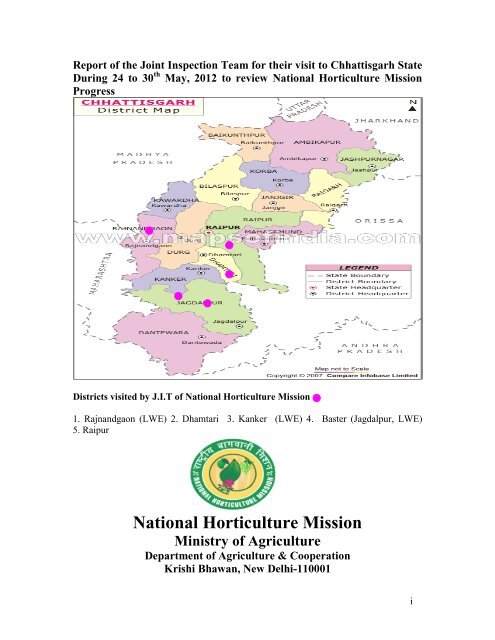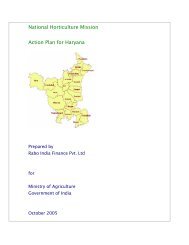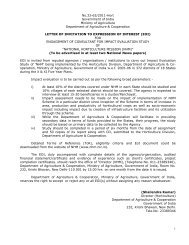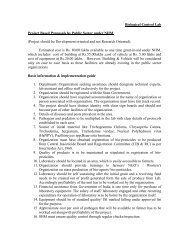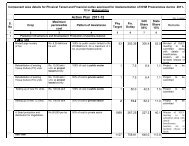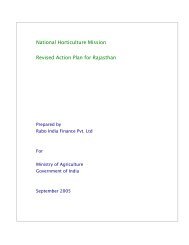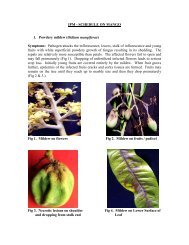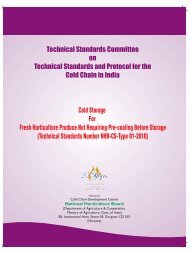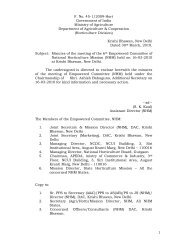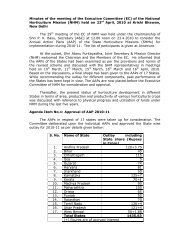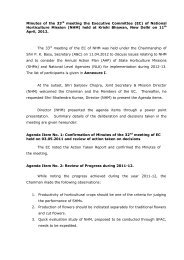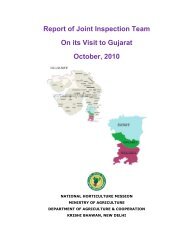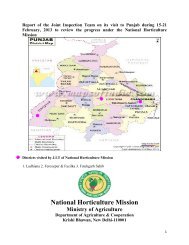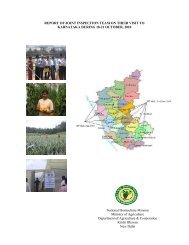Chattisgarh, May 2012 - National Horticulture Mission
Chattisgarh, May 2012 - National Horticulture Mission
Chattisgarh, May 2012 - National Horticulture Mission
Create successful ePaper yourself
Turn your PDF publications into a flip-book with our unique Google optimized e-Paper software.
Report of the Joint Inspection Team for their visit to Chhattisgarh StateDuring 24 to 30 th <strong>May</strong>, <strong>2012</strong> to review <strong>National</strong> <strong>Horticulture</strong> <strong>Mission</strong>ProgressDistricts visited by J.I.T of <strong>National</strong> <strong>Horticulture</strong> <strong>Mission</strong>1. Rajnandgaon (LWE) 2. Dhamtari 3. Kanker (LWE) 4. Baster (Jagdalpur, LWE)5. Raipur<strong>National</strong> <strong>Horticulture</strong> <strong>Mission</strong>Ministry of AgricultureDepartment of Agriculture & CooperationKrishi Bhawan, New Delhi-110001i
TABLE OF CONTENTS_______________________________________________________________________ItemPage No.________________Observation/ Actionable issues made by JIT 3INTRODUCTION 4About Chhattisgarh 4-13Status of <strong>Horticulture</strong> in Chhattisgarh 13-26VISIT OF JIT IN CHHATTISGARHVisit to Rajnandgaon district 27-34Visit to Dhamtari district 35-44Visit to Kanker district 45-48Visit to Baster district 49-58Visit to Raipur district 59-66Discussion with Director, SMD, <strong>Horticulture</strong> 67PhotographsAnnexureii
Observations /Actionable Issues1. While the State <strong>Horticulture</strong> <strong>Mission</strong> (SHM) is making good efforts to produceplanting material for fruit crops through nurseries in the Public sector, there isneed to involve private sector also to supplement the efforts.2. Steps need to be initiated to accredit existing nurseries for ensuring supply ofgood quality planting material to the farmers under NHM. Moreover, the areaexpansion activity should be confined the availability of planting material.3. Since area under banana is expanding rapidly in the State, package ofpractices for the crop needs to be disseminated to the farmers for gettingbetter yield.4. Senile orchards need to be rejuvenated in a phased manner by selecting fewtrees every year, instead of rejuvenating the entire orchard in one go.Farmers as well as field functionaries need to be trained on various aspects ofprotected cultivation through the PFDC/SAU. A training module and calendarneeds to be developed for the purpose. Moreover, farmers and fieldfunctionaries need be provided training and exposure visits to progressiveStates for gaining first hand knowledge on latest technologies in horticulturedevelopment.5. Use of highly toxic pesticides in vegetable production areas need to bediscouraged by promoting IPM technology. IPM infrastructure like Bio controllab needs to be set up in the areas where horticulture crops are beingcultivated commercially on clusters basis. Facilities of Central Integrated PestManagement Centre, Raipur could also be availed for this purpose.6. There is ample scope for convergence with MNREGA programme with NHM oncomponents like construction of ponds, trenches and fencing.7. There is good demand for micro irrigation in the State. In order to ensureproper quality and after sales service of the system, there is need for propermonitoring and quality control by the implementing agency.8. Display board with NHM logo may be placed wherever financial assistance hasbeen provided under NHM.3
Report of the Joint Inspection Team visited Chhattisgrh During 24-30 th<strong>May</strong>, <strong>2012</strong> to Review <strong>National</strong> <strong>Horticulture</strong> <strong>Mission</strong> ProgressINTRODUCTIONA Joint Inspection Team was constituted by the Component Authority to monitorthe <strong>National</strong> <strong>Horticulture</strong> <strong>Mission</strong> Progress of Chhattisgarh State during 2011-12 throughfield verification. This was communicated vide letter No. 33-7/2006 Hort., of Govt. ofIndia, Ministry of Agriculture, Department of Agriculture & Cooperation, (<strong>Horticulture</strong>Division), dated 26 th September, 2011.The Joint Inspection Team comprised of the following members –1. Dr. Om Prakash, Chief Consultant (NHM), DAC New Delhi.2. Dr. D.A.Sarnaik Prof. & Head, Department of <strong>Horticulture</strong>, Indira Gandhi KrishiVishwavidyalaya, Raipur.3. Mr. Prashant Dubey, Professor & PI,( PFDC ),IGKV, Raipur4. Shri R.R. Sharma, Assistant Director (NHM), Krishi Bhavan, New Delhi.5. Dr. Sunil Dubey, Joint Director, <strong>Horticulture</strong> / Shri Neeraj Shah, Assistant Director(<strong>Horticulture</strong>) and Nodal Officer, a nominee of SMDThe JIT conducted its preliminary field verification in the State from 24 th -30 th <strong>May</strong>,<strong>2012</strong>. The Team was accompanied by Dr. Sunil Dubey, Joint Director, <strong>Horticulture</strong> andShri Neeraj Shah, Assistant Director (<strong>Horticulture</strong>) and Nodal Officer, a nominee of SMD.The districts covered during JIT were Rajnandgaon, Dhamtari, Kanker, Baster and Raipur.A set of proformas developed by the Department of Agriculture & Cooperation were usedfor monitoring / recording the observations on progress of <strong>National</strong> <strong>Horticulture</strong> <strong>Mission</strong>.About Chhattisgarh State: The state of Chhattisgarh, with Raipur as its capital, cameinto existence on 1 st November 2000 by separation of 16 districts of Chhattisgarh regionfrom Madhya Pradesh. Chhattisgarh is situated between 17-23.7 0 N latitude and 80.40-4
83.38 0 E longitudes in Central eastern part of India with more than 20 million populations.The total geographical area of the state is 136.03 thousand sq. km.Geographical features: Geographically, Chhattisgarh is divided into three distinct landareas viz., Chhattisgarh Plains, Bastar Plateau and Northern Hill Zones.In the north of the state are the mighty Satpura Ranges, in the center the plains of RiverMahanadi and its tributaries and in the South is the plateau of Bastar. The state receivesannual rainfall ranging from less than 1200 mm to greater than 1600 mm in different areas.The border of Chhattisgarh is touched by the states Uttar Pradesh in the North, Bihar in theNorth East, Orissa in the East, Andhra Pradesh in the South and South East, Maharashtra inSouth West and Madhya Pradesh in the West. Paddy is the main crop of the state and dueto abundance of production of paddy Chhattisgarh was earlier known as 'Rice Bowl ofCentral India.'Demographic characteristics: Total population of the state is about 20.79 million with16.62 million people residing in rural area constituting more than 75% of the totalpopulation. The Scheduled Caste and Scheduled Tribe population constitutes more than45% population of the state. Education system in Chhattisgarh needs greater attentionespecially in female education. The literacy rate is 65.12% as compared to the national rateof 65.38%. The literacy rates are still lower in rural areas particularly in tribal districts likeBastar, Surguja, Jashpur and Raigarh districts.General climatic features: The general climate of Chhattisgarh state is dry sub-humidtype where the annual potential evapo-transpiration is slightly higher than the annualrainfall. The average annual rainfall of the region is around 1400 mm and about 90 to 95percent of this amount is received during southwest monsoon season (June-October). Themonsoon sets in around 10 th June in the tip of the Bastar area and covers the entire area by25 th June. Months of July and August are the wettest months. 3 Rainfall in October monthoccurs due to cyclonic activity in the Bay of Bengal and October rainfall is most crucial forthe productivity of rice in the state.5
Winter conditions set in from mid November when the average minimum temperaturestarts falling below 15 0 C. The northern districts especially Bilaspur division have moresevere and longer winter period as compared to southern parts especially Bastar division.The atmospheric humidity is very high (>90%) during monsoon months and startsdecreasing from October onwards and reaches as low as 15-20 percent during peak summermonths.Soil type: The soils of Chhattisgarh vary considerably in the three agro-climatic zones.Though the nomenclature is different, the types of the soils especially the physicalproperties are the same. The different soils that exist in the three agro-climatic zones are asfollows:Chhattisgarh Plains Bastar Plateau Northern hillsBhata (Lateritic) Marhan (Coarse sandy) Hilly soilsMatasi (Sandy loam) Tikra (Sandy) TikraDorsa (Clay loam) Mal (Sandy loam) Goda chawarKanhar (Clay) Gabhar (Clay & Clay loam) BaharaThe first two categories of the soils in the three Agro climatic zones are very lighttype of soils with very low water retentive capacity. As a result water stress or droughtconditions occur either during the crop growing season when there is a break of monsoonfor more than 5-7 days or immediately after the withdrawal of monsoon. In Bastar plateauand northern hill zone rice is grown in upland conditions without bunds and they are calleduplands. In Chhattisgarh plains rice is mostly grown under bunded condition.Therefore, there is an urgent need to diversify cropping pattern wherever conditionsare favorable to grow horticultural crops and to earn higher net profit in unit area.Agro-climatic zones: Agro-climatically, Chhattisgarh may be divided into 3 distinct agroclimate zones with immense potential of horticulture development.6
Sl.No.Agro-climaticZoneDistrictsRaipur, Mahasamund, Dhamtari, Durg, Rajnandgaon,Chhattisgarh Kabirdham, Bilaspur, Korba, Janjgir and part of Kanker1.Plains district (Narharpur & Kanker block) along with part ofRaigarh district2. Bastar Plateau Jagdalpur, Dantewada and remaining part of Kanker district.3. Northern HillsPresent Irrigation ScenarioSurguja, Koriya and Jashpurnagar and Dharamjaigarh Tehsilof Raigarh district.Source wise irrigationSl. No. Source of irrigation Area (in lac ha.) % age.1. Canals 8.76 702. Tanks 0.53 43. Tube-wells 2.06 164. Wells 0.35 35. Other Sources 0.79 7Total - 12.49 100Net irrigated area - 26Chhattisgarh is one state without power deficit. With the launching of new scheme<strong>National</strong> Agriculture Development Plan, the harnessing of the surface and sub-surfacewater resources is possible by strengthening the existing irrigation infrastructure.Importance of horticulture: <strong>Horticulture</strong> plays important role in livelihood security ofpoor farmers. It provides food security and perennial source of income to poorest of poor. Itis a dynamic tool for ensuring ecological sustainability.<strong>National</strong> <strong>Horticulture</strong> <strong>Mission</strong> in the state was effectively launched in the year2006-07. Initially 7 districts out of the 21 districts have been included in the mission. Themain focus had been on four major crops viz. Mango, Litchi, Cashew and Lime. Alongwith the main crops five crops namely Chilli, Ginger, Garlic, Coriander and Turmeric havebeen taken up essentially as inter crops. Later in the year 2007-08, four additional districtsnamely Raipur, Korea, Jashpur and Rajnandgaon were included in the action plan. Recentyear six new crops were included in the list of main crops, they were Jamun, Aonla, Ber,Bael, Sitaphal and Banana and crops such as Lemon grass, Patchouli, Khus, E. citriodora,7
Palmarosa, Jamarosa, Alovera, Sarpagandha, Ashwagandha and Bach have been selectedas intercrop.Perennial source of income: Land and water are two most important natural endowmentsbut they are renewable but finite resources. However, with judicious mix of interventionslike development of irrigation facilities, application of improved and modern horticulturalpractices and creation of other income generation activities based on natural resources, thepossibilities of creating perennial source of income can be enhanced. Perennial source ofincome can be ensured through –I. Development of infrastructure especially for irrigation.II. Value addition and processing of horticulture produce.III. Vermi-composting in rural areas to promote organic farming.Objectives1. To improve the well being of indigenous and local communities by adoptingintegrated horticulture development and livelihood development.2. To augment the income of landless farmers, rural women, marginalized socialgroups and small farmers of selected tribal dominated villages in the state.3. To convert the existing conventional cultivation into organic and certifiable farmingof horticultural crop.4. To develop, refine and transfer grading, processing, value addition, marketing,certification and marketing technologies, methods, options and information system.5. To build capacity of local organizations to plan and implement entrepreneurshipdevelopment, business plan development and micro enterprise management.8
6. To assess appropriate technologies and if necessary upgrade cultivation practicesand local processing technology.7. To ensure the preparation of <strong>Horticulture</strong> plans for the districts and states to achievethe goal of reducing the yield gaps in important crops through focused interventioni.e. through production of vegetable seeds of improved variety, propagation ofquality planting material under the nurseries of government as well as privatesector.8. To maximize returns to the farmer in the <strong>Horticulture</strong> and it's allied sectors.9. To address the <strong>Horticulture</strong> and allied sectors in an integrated manner and therebybring about quantifiable changes in the production and productivity of Horticulturalproduce.10. To meet out the nutritional requirement of the people of the state living belowpoverty line.Cluster Approach in Chhattisgarh: In Chhattisgarh clusters are formed based on cropsand the area of the crop under cultivation is the focus point. A cluster consists of 250.50acres in one patch will 10-20 villages in radius of 15.20 kms. One village should haveminimum of 10 hectares under one crop to qualify as a cluster. A micro cluster constitutesa single crop in a small area under a few farmers in one or two villages.Under the crop based cluster approach till 2011-12, total 812 clusters in 11districts have been formulated in 6087 villages with 141042 beneficiaries and an area of190284 ha (Table). These clusters were formulated on the basis of area expansion programof <strong>National</strong> <strong>Horticulture</strong> <strong>Mission</strong>. The key component of cluster approach of Chhattisgarhwas orchard development, mandatory intercropping of aromatics/medicinal plants/spices,micro irrigation and vermi-composting.9
Sl.No.Particulars<strong>National</strong> <strong>Horticulture</strong> <strong>Mission</strong> (Chhattisgarh ) - At GlanceAAP2005-06,2006-07AAP2007-08AAP2008-09AAP2009-10AAP2010-11AAP2011-12 Total1Districts117 11 11 11 11Selected622Number of23054 134 106 112 176clusters8123Number of2000391 1007 547 799 1343Villages60874Number of241319500 33708 19181 23496 31026farmers1410425 Area (ha.) 12659.3 38114 28381.5 74195 25033.75 11900 1902846 Main crops Mango,Litchi,Cashew,Mango, Litchi,Cashew, Lime,Aonla, Jamun,---Lime Bel, Ber,7 Inter crops -Aromatic CropsFlower CropsPatchouli,Jamarosa,Palmarosa,Lemongrass,VettiverMarigold,CrysanthemumSpices Crops Chilli andGingerSitaphalBananaandPatchouli,Jamarosa,E.Citridora,Aloevera,Ashwagandha,Lemongrass,VettiverRajnigandha,Gladuolus,Marygold,Crysanthemum, Anthuriumand GerberaChilli andGinger,Corriander,Methi andTurmericMango,Litchi,Cashew,Lime,Aonla,SitaphalPapaya andBananaPatchouli,Palmarosa,E.Citridora,Aloevera,Lemongrass,VettiverRajnigandha, MarygoldGarlic,Chilli,Coriander,Ginger,Methi andTurmericMango,Lime,Litchi,Aonla,Sitaphaland BananaVettiver,Citridora,LemongrassRose,Gerbera,Rajnigandha,Gladuolus,Marygold,Chrysanthemum,GlardiaMango,Lime,Litchi,Aonla,Guava,CustardAppleVittiver,Palmarosa,E.Citridora, LemongrassRose,Galardia,Rajnigandha,Gladioulus,MarigoldGarlic,Chilli,Coriander,Methi,Ginger &TurmericMango,Litchi,Lime,Guava,Cashew &BananaE.citridora,Palmarosa, Lemongrass &VettiverRajnigandha,Gladiolus&MarigoldChilli,Coriander,Gingerand &Turmeric---------Out of these 41 selected for supporting various activities. These technicalorganizations are paid Rs.1500.00 per farmer for training on cultivation pattern ofhorticultural crops and related activities. Each cluster document contains:-10
I. Identification of farmers, detail of farmers and formation of clusters.II. Conducting Cluster Level Trainings (Village wise Extension) on-site as wellas off-site.III. Practical Training on land preparation.IV. Preparation of Cluster Irrigation Plans (Based on community concept).V. Practical Training on Plantation.On the basis of cluster document cluster booklet is formulated. Main content ofcluster booklet areI. Village wise farmer’s list and the selected crops along with their khasraII.III.IV.numbers (Main Cluster Data – MCD)Cluster Irrigation Plan (CIP)Cluster Processing Plan (CPP)Cluster Extension Plan (CEP)Reporting Methodology• Cluster Coordinator reports to NHM Cell at the Directorate level.• Reporting to be done on Daily Basis in prescribed format.• Daily Reports to be sent via, Email, Fax or in person or any other possiblecommunication source.• Failure to comply with reporting leads to termination of contract.• NGO and Department send daily reports separately.• Flying squad operation (from Directorate, Raipur) to verify and cross checkfrom field.• <strong>Horticulture</strong> Department adopting cluster approach for Horticultural cropsarea expansion11
III.IV.Training and awareness of the farmers/growers on processing technology ofdifferent horticultural crops.Harvesting of different crops, processing and packaging.V. Developing market network and linkages and marketing of the products.ImpactI. By promoting technology interventions at the downstream end of the productsII.III.will help in value addition of the products and increase their price at one handand reduce the vulnerability of perishing the products on the other.Development of processing facilities for different seeds and vegetable crops willincrease the shelf value and minimize the losses to the farmers due to glut ofHorticultural produce in the market during the peak production season.By providing facilities for value additions of crops like Medicinal and Aromaticcrops farmers will get higher income from there produce.Status of <strong>National</strong> <strong>Horticulture</strong> <strong>Mission</strong> in ChhattisgarhThe Centrally sponsored Scheme of <strong>National</strong> <strong>Horticulture</strong> <strong>Mission</strong> (NHM) is beingimplemented in a <strong>Mission</strong> mode approach to address alL the issues related to holisticdevelopment of <strong>Horticulture</strong> in the State since 2005-06.The Programme in the State of Chhattisgarh is being implemented by the State<strong>Horticulture</strong> Development Society through District <strong>Mission</strong> Committees involving farmers,Societies, NGOs, Grower Associations, SHGs, State Institutions etc. The district coveredunder the programme includes Surguja, Raigarh, Korba, Bilaspur, Kabirdham, Durg,Jagdalpur, Raipur, Rajandgaon, Jaspur and Korea.The focus crops id;entified under the programme include Mango, Cashew, Litchi,Patchouli, Jamrosa, Vetivera, Citriodora, Chrysanthemum, Marigold, Cycalyptus, Chilies,Garlic and Coriander.Major activities being undertaken in the programme are production and distributionof planting material, vegetable seed production, area expansion, rejuvenation of crops,creation of community water resources, protected cultivation, IPM/INM, organic farming,13
pollination support, development of post harvest management & marketing infrastrcdtureand human resources development.Physical and Financial achievement under <strong>National</strong> <strong>Horticulture</strong> <strong>Mission</strong> inChhattisgarh during 2011-12Sl.No ComponentPhysical1Financial (Rs. In lakh)%shareoftotalGOI State TotalPlantation infrastructure &development 110 100.95 672.99 791.75 6.42Planting material 0.00 0.00 0.002 Area Expansion 32085 611.28 4075.19 4794.34 38.88New area 0.00 0.00 0.001st Year maintenance 0.00 0.00 0.002nd year maintenance 0.00 0.00 0.003 Rejuvenation 500 9.56 63.75 75.00 0.614 Mushrooms 9 26.78 178.50 210.00 1.705 Community tanks 525 91.39 609.28 716.80 5.816 Protected cultivation (ha) 120300 34.48 229.86 270.42 2.197 INM/IPM 29.96 199.75 235.00 1.918 Organic farming 190.93 1272.88 1497.50 12.149 GAP Certification 4000 25.50 170.00 200 1.6210 HRD 3136 13.55 90.35 106.29 0.8611 <strong>Horticulture</strong> Mechanization 307 36.36 242.42 285.20 2.31Beekeeping (No. of colonies /hives) 0.00 0.00 0.001213 Technology dissemination 0.00 0.00 0.0014 PHM & marketing 0.00 0.00 0.00PHM 1773 310.18 2067.84 2432.75 19.73Markets 17 16.51 110.08 129.50 1.0515 <strong>Mission</strong> Management 12 74.88 499.18 587.27 4.76Total 1572.31 10482.05 12331.82 100.00Major activities being undertaken in the programme are production anddistribution of planting material, vegetable seed production, area expansion, rejuvenationof crops, creation of community water resources, protected cultivation, IPM/INM,organic farming, pollination support, development of post harvest management &marketing infrastructure and human resource development.14
Physical ProgressUnder the <strong>Mission</strong>, during 2005-06 to 2011-12.An additional area of 158216.27 ha of identified horticulture crops has beencovered.75 nurseries for production of quality planting material have been established.3370 ha, has been brought under rejuvenation of old and senile orchards.Coverage of 229 ha under vegetable seed production.Adoption of organic farming in an area of 4645 ha for promotion of organiccultivation in horticultural crops.Establishment of 62320 number of vermi- compost units.An area of 6812 ha. has been brought under adoption of IPM practices andestablishment of 3 IPM infrastructure including 2 bio control labs and 1 leaf/tissueanalysis lab.5041 water harvesting structures have been created.Under the component of Post Harvest Management, 895 units (741 pack houses140 evaporative / low energy cool chambers, 10 low cost onion storage and 4 coldstorage) have been established.Apart from setting up of 4 whole sale markets.Total number of 71031 farmers have been trained under various horticultureactivities.Financial ProgressDuring 2005-06 to 2011-12, an amount of Rs. 412.77 crore was released to theState. The State has reported an expenditure of Rs. 434.49 crore.An allocation of Rs. 125 crore including GOI share of Rs. 106.25 crore has beenearmarked for <strong>2012</strong>-13 and SHM has been requested to recast its Annual Action Plan<strong>2012</strong>-13 with stipulated amount.15
Year–wise details of Outlay, Fund Released and Expenditure under NHM inChhattisgarh(Rs. in crore)Year Outlay Releases Expenditure BalanceTotal GOI2005-06 50.29 50.29 23.68 3.43 20.252006-07 111.92 111.92 55.00 47.33 27.922007-08 154.13 131.01 62.52 33.57 56.872008-09 126.46 107.49 30.00 84.76 2.112009-10 82.24 69.90 60.00 66.71 -4.602010-11 115.00 97.75 96.57 83.38 8.592011-12 110.00 93.50 85.00 115.31 -21.72Chhattisgarh produce 5.94 m MT of horticultural produce from an area of 0.59 m.ha and accounts for 2.47 % of horticultural production in the country. Major share ofproduction of horticulture produce is from Vegetables (71.49%) and fruit (26.41%).Tomato Chhattisgarh accounts for 4% of total production of tomato in the country andproduces about 0.63 m. MT of tomato from an area of about 0.04 m ha.productivity of crop is 14.6 t/ha.The major tomato producing belts in the State are Raipur, Durg, Baster.ThePotato Chhattisgarh is producing about 0.53 m MT of potato from an area of about 0.03m. ha with productivity of 14.5 t/ha.Brinjal Chhattisgarh accounts for 4% of total production of Brinjal in the country and isproducing about 0.44 m. MT of Brinjal from an area of about 0.03 m. ha withproductivity of 16.5 t/ha.Cabbage Chhattisgarh accounts for 3% of total production of cabbage in the country and isproducing about 0.26 m. MT of cabbage from an area of 0.02 m ha havingproductivity of 17.5 MT/ha.16
Cauliflower The State is producing about 5% of the total cabbage production in the country.The production of cabbage is about 0.31 m MT from an area of 0.02 m ha havingproductivity of 16.6 MT/ha.OkraThe State is contributing about 4% of the total production of okra in the country.It produces about 0.25 m MT of okra form an area of 0.03 m ha with productivityof 9.9 MT/ha.The major okra producing belts in the State are Raipur, Durg, Rajnandgaon.PeasChhattisgarh contributing about 4% of total production of Peas in the country.Production of peas is 0.01 m. MT from an area of 0.01 m ha with productivity of9.2 MT/ha.Banana Among fruits, banana is the major crop involving a production of 0.4% m. MTfrom an area of 0.01 m ha. forming 22% of the total fruit production in the State.Papaya Chhattisgarh is the sixth leading producer of papaya in the country.State produces about 6% of Papaya in the country. The production is 0.25 m. MTfrom an area of 0.01 m ha with productivity of 23.3 MT/ha.Guava Chhattisgarh produces about 4.2% of the total production of guava in the country. Production guava in the State is 0.01 m ha with productivity of 7.7 MT/ha. Major guava producing belts in t he State are Raipur, Durg and Jagdalpur.17
Sl.No.List of Departmental Nurseries Selected for up gradation as Model Nursery (Yearwise)Dist. Name Year 05-06 Year 06-07 Year 07-08 Year 08-09 Year 09-10 Year 10-11 Year 11-121. 2. 3. 4. 5. 6. 7. 8. 9.1 Jagdalpur Govt.Horti.Nur.Asna (Block-Jagdalpur)Govt. Horti.Nur.Kopabeda(Block-Kondagaon)Govt. Horti.Nur. Tevesha(Block-Visharampur)1. Bademarenga(Block-Tokapal)2. Adenga(Block-Keshkal)Fharasgaon(Block-Fharasgaon)1. BadangiBlock-Lohandiguuda2. SorgaonBlock- Bastar2 Durg Aheri(Block-Dhamdha)Ruabandha(Block-Durg)Atari (Block-Patan)Parkidih(Block-Bemetra)1.Berla (Block-Berla)2. Arjunda(Block- Durg)3. Achholi(Block )4. Navagarh(Block - )1. MoharaBlock - Gurur3 Korba Patadi(Block-Korba)4 Surguja Belkota(Block-Lakhenpur)Podilapa(Block-Pali)Ambikapur(Block-Ambikapur)Patiyapali(Block-Kertela)Datima (Block-Surejpur)Nagoi(Block-Kodiuprora)Gumgarakala(Block-Lakhanpur)Pandaripani(Block- Katghora)Pratappur (Block-Khorma)Shivpur, Block-Ramanuj nagarOberiBlock-Balrampur5 Bilaspur Lalpur(Block-Gaurella)6 Kabirdham Khutu (Block-Kabirdham)7 Raigarh Dharmjaigarh(Block-Dharmjaigarh)Sarkanda(Block-Bilaspur)Lalpur(Block-Bodla)Boeirdadar(Block-Raigarh)Pathgawan 1. Masturi(Block- Pendra) (Block-Masturi)2. Sharda(Block- Lormi)3. Bahtarai(Block-Takhatpur)Mohtara(Block-Pandariya)Gharghoda(Block-Gharghoda)Sahas-Lohara(Block- Sahas-Lohara)Bandhatola(Block-Pussour)1. Kargikala(Block- Kota)2. Baghamuda(Block- Mungeli)3. Sendari (Block-Pathariya)No Nursury1. Kunjara(Block- Lailunga)2. Anjoripali(Block- Kharsiya)3. Nadigaon(Block-Baramkela)MarwahiBlock-MarwahiKhutuBlock –KabirdhamBasanpallBlock- TamnarLalpurBlock-GourelaBeltikeriBlock-Sarangarh8 Raipur - - Kharkhara(Block-Chura)Kachlon(Block- Simga)1. Madhi (Block-Tilda)2. Semariya(Block- Palari)Kharri belariBlock- Kasdol1. ParagaonBlock-Arang2. HasadaBlock-Bhatapara9 Jashpur - - Jashpur nagar Duldula (Block- Kalmitikada 1. Budadand Tempo18
(Block- Jahpur) Duldula)(Bloc-Pathalgaon)Block – Bagicha Block-2. Pandripani ManoraBlock-Pharsabahar10 Koriya - - Sorga (Block-Baikunthpur)Janakpur(Block-Bhartpur)Ghughra (Block-Sonhat)SoragaBlock –BankunthpurChirmiBlock-Khadgaonwa11 Rajnandgaon- - Pendri (Block-Rajnandgaon)Dorba (Block-Manpur)Acholi (Block-Dongargarh)Total 7 7 11 14 18 18 11 6Plantation Programme in the State to be undertakenSl.No.Year(area in ha, rupees in lakh) (2011-12)CropTargetAchievementPhysical Financial Physical FinancialMango 900 89.10 900 89.10Banana 5019 1139.58 5019 1139.58Litchi 400 42.30 400 42.30Lime 250 39.76 202 32.21Anola - - - -Sitaphal 200 19.76 200 19.76Guava 650 64.20 607 59.75Cashew 150 18.00 122 14.57Chilli 4620 577.50 4620 577.50Garlic - - - -Ginger 2700 337.50 2700 337.50Coriander 950 118.75 950 118.75Turmeric 3200 400.00 3200 400.00Methi 300 37.50 21 2.61Rose 55 19.25 55 19.25Gerbera 100 35.00 100 35.00Rajnigandha 1200 540.00 1200 540.00Gladiolus 1300 585.00 1300 585.00Marigold 1025 123.00 1025 123.00Chysamthimus - - - -Galardia - - - -Vetiver 150 18.75 150 18.75E.Citridora 200 25.00 200 25.00Pamarosa 100 12.50 100 12.50Lemongrass 400 50.00 400 50.00Total - 4292.45 4242.1319
Rejuvenation programme undertaken in the State (2011-12)(Area in ha., Rs. in lakh)Sl.TargetAchievementYearNo.Physical Financial Physical Financial1 2005-06 2450 367.50 0 0.002 2006-07 1420 213.00 1420 213.003 2007-08 1200 180.00 0 0.004 2008-09 950 142.50 950 142.505 2009-10 250 37.50 0 0.006 2010-11 500 75.00 500 75.007 2011-12 500 75.00 500 75.00Total - 7270 1090.50 3370 505.50Requirement of planting material for area expansion of fruit crops under NHM Year<strong>2012</strong>-13Sl. Name of Target No. of Total No. of Source of ProcurementNo. Crops (in ha.) plantsper ha.requirement DepartmentalNurseriesOtherSourcesRemarks1. 2. 3. 4. 5. 6. 7. 8.1 Mango 1000 100 100000 50000 50000CG StateSeed Corp.2 Litchi 300 150 45000 45000 - -3 Lime 300 277 83100 83100 - -4 Aonla - - - - - -5 Guava 500 277 138500 131500 7000CG StateSeed Corp6 Custard Apple - - - - - -7 Banana 800 2252 1801600 - 1801600CG StateSeed Corp8 Cashew nut 8000 200 1600000 - 1600000OSCDCOdissaTotal - 1090020
Sl.No.Physical and Financial Progress under NHM Year : 2011-<strong>2012</strong>ProgrammeUnitScale Per Unit(lakh)Subsidy(ProposedAssistance)Targets as perapproved actionplanTargets as perFund Released(Rs. in lakhs)AchivementPhy. Fin. Phy. Fin. Phy. Fin.1. 2. 3. 4. 5. 6. 7. 8. 9. 10. 11.A. Plantation Infrastructure & Development -1. Production of planting material -i) Model Nursery -(a) Model Nursery (2 to 4 ha.) inPublic Sector (Rs.6.25 lakh/oneha. unit)ii) Small Nursery -(a) Small Nursery (1 ha.) in PublicSector (Rs.6.25 lakh/one ha. unit)No. 25.000 25.000 10 250.00 10 255.59No. 6.250 6.250 3 18.75 0 0.00iii) Seed Infrastructure ( PublicSector)1 100.00Total 13 268.75 11 355.59iv) Seed production and distribution for Vegetables -(a) Seed Production (PublicHa. 0.500 0.500 51 25.50 31 15.50sector)(b) Seed Production (Privatesector) - @50% subsidy.2. Establishment of New Gardens (Area Expansion) -I. Fruits -Ha. 0.500 0.250 25 6.25 25 6.25Total 76 31.75 56 21.75(a) Cost intensive crops (For a maximum area of 4 ha. per beneficiary)iii) Banana (TC) (@50% subsidy) Ha. 0.832 0.312- 75% subsidy on plantingmaterial in 1st year.Ha. 0.832 0.312 2969 926.37 3495 1090.83I. - 25% subsidy on plantingmaterial in 2ndyear.Ha. 0.832 0.104 2050 213.21 3353 349.10Sub total - 5019 1139.58 6848 1439.94(c) (i) Fruit crops other than costintensive crops using normal Ha. 0.400 0.300spacing. (@75% subsidy)- 60% subsidy on planting material in 1st year -a) Mango Ha. 0.220 0.099 900 89.10 1053 105.63b) Litchi Ha. 0.235 0.106 400 42.30 529 56.09c) Lime Ha. 0.3534 0.159 250 39.76 202 32.21e) Guava Ha. 0.2195 0.0988 650 64.20 607 59.75f) Custard Apple Ha. 0.220 0.0988 200 19.76 204 20.16- 20% subsidy on planting material in 2ndyear -Sub total - 2400 255.12 2595 273.83a) Mango Ha. 0.220 0.033 1200 39.60 1200 39.60b) Litchi Ha. 0.235 0.0353 230 8.11 230 8.11c) Lime Ha. 0.3534 0.053 280 14.84 280 14.84d) Aonla Ha. 0.2334 0.035 350 12.25 350 12.25e) Guava Ha. 0.2195 0.033 100 3.29 100 3.29f) Custard Apple Ha. 0.220 0.033 200 6.60 200 6.60Sub total - 2360 84.70 2360 84.7021
- 20% subsidy on planting material in 3rd year -a) Mango Ha. 0.220 0.0495 850 42.08 850 28.05b) Litchi Ha. 0.235 0.0529 180 9.52 180 6.35c) Lime Ha. 0.3534 0.0795 50 3.98 50 2.65d) Aonla Ha. 0.2334 0.0525 100 5.25 100 3.50II. Mushrooms -Sub total - 1180 60.82 1180 40.55Total 10959 1540.22 1839.01(a) Integrated mushroom unit for spawn, compost production and training -ii) Private Sector (@50%subsidy). Unit 50.000 25.000 2 50.00(b) Spawn making unit -0 0.00i) Public Sector Unit 15.000 15.000 1 15.00 0 0.00(c) Compost making unit -i) Public Sector Unit 20.000 20.000 1 20.00 0 0.00Total 4 85.00 0.00III. Flowers (For a maximum of 2 ha. per beneficiary) -(a) Cut Flowers -i) Small & Marginal Farmers (@50% subsidy).a) Rose Ha. 0.700 0.350 55 19.25 114 39.98b) Gerbera Ha. 0.700 0.350 100 35.00 140 48.80(b) Bulbulous Flowers -Small & Marginal Farmers (@50% subsidy).Sub total - 155 54.25 254 88.78III. a) Rajnigandha Ha. 0.900 0.450 1200 540.00 1913 859.50b) Gladiolus Ha. 0.900 0.450 1300 585.00 1930 877.46(c) Loose Flowers -i) Small & Marginal Farmers (@50% subsidy).Sub total - 2500 1125.00 38431736.96a) Marigold Ha. 0.240 0.120 1025 123.00 1571 188.41TotalIV. Spices (For a maximum area of 4 ha. per beneficiary) -Seed spices and Rhizomatic Spices. (@50% subsidy)3680 1302.25 5667.3 2014.15b) Chilli Ha. 0.250 0.125 4620 577.500 7199 899.99c) Coriander Ha. 0.250 0.125 950 118.750 1214 151.52d) Methi Ha. 0.250 0.125 300 37.500 21 2.61e) Ginger Ha. 0.250 0.125 2700 337.500 3800 475.00f) Turmeric Ha. 0.250 0.125 3200 400.000 4084 510.48Total 11770 1471.250 16318.02 2039.59V. Aromatic Plants (For a maximum area of 4 ha. per beneficiary) -(a) Cost intensive aromatic plants (Patchouli, Geranium, Rosemary, etc.) - @50% subsidy(b) Other aromatic plants. (@50% subsidy)a) E-Citridora Ha. 0.250 0.125 200 25.00 486 60.73b) Pamaroza Ha. 0.250 0.125 100 12.50 100 10.00c) Vetiver Ha. 0.250 0.125 150 18.75 150 18.75d) Lemon-Grass Ha. 0.250 0.125 400 50.00 600 75.00Total 850 106.25 1336 164.4822
VI. Plantation crops (For a maximum area of 4 ha. per beneficiary) -(a) Cashew & Cocoa includingreplanting - (@50% subsidy).Ha. 0.400 0.200- 60% subsidy on plantingmaterial in 1st year.Ha. 0.200 0.120 150 18.00 122 14.57- 20% subsidy on plantingmaterial in 2ndyear.Ha. 0.150 0.0225 970 21.83 970 21.83- 20% subsidy on plantingmaterial in 3rd year.Ha. 0.150 0.0338 150 5.06 100 3.38Total 1270 44.89 39.773. Rejuvenation / replacement ofsenile plantation includingCanopy management. (@50%subsidy to a limited of 2 ha. perbeneficiary)4. Creation of water resources -(a) Community Tanks -Ha. 0.300 0.150 500 75.00 500 75.00i) Community tanks/on farm ponds/on farm water reservoirs with use of plastic/RCC lining - (10 ha. of command area, with pondsize of 100m x 100m x 3m) -- In Plain areas No. 15.000 15.000 15 225.00 0 0.00(b) Water harvesting system for individuals - for storage of water in 20m x 20m x 3m ponds/wells @Rs.100.00 cum (@50%subsidy) -- In Plain areas No. 1.200 0.600 70 42.00 0 0.00- In Hilly areas No. 1.380 0.690 20 13.80 0 0.00(c) Borewells -Sub total - 90 55.80 0.00- In Plain areas No. 0.700 0.700 200 140.00 200 140.00- In Hilly areas No. 0.700 0.700 100 70.00 100 70.005. Protected Cultivation -1. Green House Structure -Sub total - 300 210.00 300 210.00Total405 490.80 300210.005(a) Fan & Pad System(Rs.1465.00 sq.m. @50% subsidyof the cost limited to 4000 sq.m.per beneficiary).(b) Naturally ventilated System-i) Tubular Structure (Rs.935.00sq.m. @50% subsidy of the costlimited to 4000 sq.m. perbeneficiary).2. Plastic Mulching (@50%subsidy of the total cost limited to2 ha. per beneficiary).3. Shade Net House -i) Tubular Structure (Rs.600.00sq.m. @50% subsidy of the costlimited to 1000 sq.m. perbeneficiary).Sq.Mtr. 0.01465 0.0073 8000 58.60 83 60.78Sq.Mtr. 0.0094 0.0047 27000 126.23 25487 119.28Ha. 0.20 0.10 2800 280.00 3387 338.66Sq.Mtr. 0.006 0.003 9000 27.00 2000 6.00Total --- 491.83 524.716 Promotion of Integrated Nutrient Management (INM) / Integrated Pest Management (IPM) -ii) Promotion of IPM/INM(Rs.2000.00/ha. @50% subsidy ofcost subject to a maximum ofRs.1000.00/ha. limited to 4ha./beneficiary).No. 0.02 0.01 20000 200.00 17729 193.3823
iii) Disease forecasting unit(Public Sector)Unit 4.00 4.00 1 4.00 0 0.00Total --- 204.00 17729 193.387 Organic Farming -(a) Adoption of organic farming (Rs.20,000.00 - @50% subsidy of cost limited to Rs.10,000.00/ha. for a maximum area of 4 ha. per beneficiary) -i) 40% subsidy in 1st year. Ha. 0.10 0.04 500 20.00 900 36.00ii) 30% subsidy in 2nd year. Ha. 0.10 0.03 1500 45.00 0 0.00iii) 30% subsidy in 3rd year. Ha. 0.10 0.03 1250 37.50 0 0.00Sub total - 3250 102.50 900 36.00(b) Organic Certification (Rs.5.00 lakh for a cluster of 50 ha.) -i) 30% subsidy in 1st year Cluster 5.00 1.50 10 15.00 133 198.50ii) 30% subsidy in 2nd year. Cluster 5.00 1.50 30 45.00 0 0.00iii) 40% subsidy in 3rd year. Cluster 5.00 2.00 15 30.00 0 0.00Sub total - 55 90.00 133 198.50(c) Vermi compost units/organic input production unit -ii) 50% of cost conforming forHDPE Vermibed to the size of 96cft (12'x4'x2') to be administeredon pro-rata basis.8 Certification for GoodAgricultural Practices (GAP),Including infrastructure -(@50% subsidy)No. 0.100 0.050 34417 1720.85 35303 1738.31Total --- 1913.35 1972.81Ha. 0.100 0.0509 Pollination support through beekeeping -(c) Honey bee colony(Rs.1400.00/colony of 4 farmers@50% subsidy of cost limited toNo. 0.014 0.007 650 4.55 464 3.2550 colonies/beneficiary).(d) Hives (Rs.1600.00/hive @50%subsidy of cost limited to 50 No. 0.016 0.008 650 5.20 0 0.00colonies/beneficiary).(e) Equipment including honeyextractor (4 farmer), food gradecontainer (30 kg), net, etc.(Rs.14,000.00/set @50% subsidyNo. 0.140 0.070 65 4.55 0 0.00of the cost limited to one set perbeneficiary).Total 1365 14.30 3.2510 <strong>Horticulture</strong> Mechanization -(a) Power operated machines/tools including Power Saw andPlant Protection equipments etc. No. 0.350 0.175 50 8.75 0 0.00(@50% subsidy limited to one setper beneficiary).(c) Power Machines (20 HP &above including accessories /equipments) - @50% subsidyNo. 3.000 1.500 250 375.00 250 375.00limited to one set per beneficiary.Total 300 383.75 375.0011 Human Resource Development (HRD) -(b) HRD for Gardeners. No. 15.000 15.000 1 15.00024
(c) Training of Farmers -i) Within the district (Rs.400.00/day per farmer excludingtransport, 2 days training isproposed.(e) Exposure visit of farmers -No. 0.008 0.008 925 7.400 925 7.40i) Within the district (Rs.250.00/day per farmer excludingNo. 0.0025 0.0025 475 1.188 475 1.19transport, 1 day visit is proposed.iv) Outside of India (Rs.3.00 lacper participant)No. 3.000 3.000 20 60.00 1 20.00Sub total - 495 61.188 476 21.19(f) Training/Study Tour of Technical Staff/Field Functionaries -ii) Study tour to progressiveSates/Units (group of minimum 5participants @ Rs.650.00/day perparticipant plus TA/DA, asNo. 0.046 0.046 35 1.593 0 0.00admissible, 7 days tour isproposed).iii) Outside of India (Rs.5.00 lacper participant)No. 5.00 5.00 10 50.00 0 0.00Sub total - 45 51.593 0 0.00Total1466 135.18 1401 28.59C. Integrated Post Harvest Management -i) Pack house/On farmcollection & storage unit(Rs.3.00 lakh/per unit with sizeof 9m x 6m - @50% subsidy).No. 3.000 1.500 431 646.50 431 646.50ii) Cold storage units (Construction/Expansion/Modernization) -(a) Rs.6000.00/MT credit linkedback-ended subsidy @40% of thecapita cost of project in GeneralNo. 300.000 120.00 6 720.00 1 52.92areas for 5000 MT capacity.(b) Rs.6000.00/MT credit linkedback-ended subsidy @55% of thecapita cost of project in Hilly & No. 300.000 165.00 0 0.00 0 0.00Scheduled areas for 5000 MTcapacity.Sub total - 6 720.00 52.92iii) Processing units -(a) Cashew nut processing unitcredit linked back-ended subsidy@40%.iv) Ripening chamber -No. 15.000 6.00 6 36.00 0 0.00(a) Rs.6000.00/MT credit linkedback-ended subsidy @40% of thecapita cost of project in GeneralNo. 300.000 120.00 1 120.00 0 0.00areas for 5000 MT capacity.(b) Rs.6000.00/MT credit linkedback-ended subsidy @55% of thecapita cost of project in Hilly & No. 300.000 165.00 0 0.00 0 0.00Scheduled areas for 5000 MTcapacity.Sub total - 1 120.00v) Evaporative / low energy coolchamber (8 MT) - @50%subsidy.No. 4.000 2.00 140 280.00 140 280.00vi) Low cost onion storage unit No. 1.000 0.50 10 5.00 10 5.00Total 584 1807.50 984.4225
D. Establishment of Marketing Infrastructure for Horticultural Produce -i) Terminal markets (Rs.150.00crore/project @25% to 40%(limited to Rs.50.00 crore) as No. 15000.0 1000.0 0 0.00 0 0.00Public-Private Partnership modethrough competitive bidding.iii) Rural Markets/Apni Mandies/Direct Markets -(a) Credit linked back-endedsubsidy @40% of the capital cost Unit 20.000 8.000 9 72.00 0 0.00of project in General areas.(b) Credit linked back-endedsubsidy @55% in case of Hilly &Scheduled areas for individualUnit 20.00 11.00 2 22.00 0 0.00entrepreneurs.Sub total - 11 94.00 0.00iv) Retail Markets / Outlets (environmentally controlled) -(b) Credit linked back-endedsubsidy @55% in case of Hilly &Scheduled areas for individualUnit 10.00 5.50 2 11.000 0 0.00entrepreneurs.viii) Market extension, qualityawareness & market ledextension activities for freshproducts (100% assistance toNo. 3.00 3.00 2 6.000 0 0.00State Govt./SHM/Public SectorAgencies).Total --- 111.00 0.00F. <strong>Mission</strong> Management -Total Project Cost - 10477.06 10841.50I. State Level -(a) State & Districts <strong>Mission</strong> Offices and implementing agenciesfor administrative expenses, project, preparation, computerization,contingency etc.(b) (i) Institutional Strengthening,hire/purchase of vehicles.Project 5.50 5.50 0 125.00Based(ii) Hardware/software. L.S. 0 20.000 224.31 0 689.04(c) Seminars, conferences, workshops, exhibitions, Kisan Mela, horticulture shows, honey festivals etc. -ii) District level (Rs.2.00 lakh perevent of two days).(d) Technical Support Group(TSG) at State Level for hiringexperts/staff, studies, monitoring& evaluation, mass media,publicity, video conference etc.No. 2.00 2.00 12 24.00ProjectBased50.00 50.00 0 129.66Total - --- 522.97 689.04Grand Total - 11000.03 11530.5426
RAJNANDGAON (LWE) DISTRICTRajnandgaon surrounds the Kabirdham district in north, Kanker in south, Durg ineast and Balaghat district of M. P. in west. The Rajnandgaon district is administrativelydivided in three sub-divisions along with 9 Block in which 696 gram panchayat and 1680villages.PROFILE -Geographical area 8,02,252 ha. (5.82 % of the state).Net sown area 3,65,323 ha. (45.53% of its geographical area).Total horticulture area during 2008-09 - 0.14 lakh ha.(3.8% of its net sown area )Proposed horticulture area (after 5 years 2014-15) - 0.2 lakh ha. (5.47 % of its net sownarea).Percentage increase after 5 years from the 2008-09 – 42.5%.60% soil is medium to light.Forest covers 2.59474 lakh ha. (32.34 % of its geographical area).Average rainfall 1274 mmFarm families: 2.55546 lakh (27 % ST, 10 % SC). 49.98 % marginal farmers own 34.96% land. 25 % small farmers own 35% land 74.98% Small / Marginal Farmers own69.96% land 25.02% others own 30.04 % land.Average land holding: 1.42 ha.Under fruits Mango is a major crop which occupies 1032 ha of the total croppedarea of fruits (1818 ha.) Under Spices Chili is major crop which occupies 1055 ha. of thetotal cropped area of spices (2217 ha.).Under Vegetables Potato is major crop whichoccupies 1250 ha. of the total cropped area of Vegetables ( 9787 ha.).Area under Rabi crops 1.419 lakh ha. which constitutes only 38% of the net sownarea. Net irrigated area 93.450 lakh ha. (25.5 %), cropping intensity 135%.27
Geography and Climate -General climatic features: The most favoured factor of Rajnandgaon district is climate.Climatic conditions are very idle for growing most of the horticulture crop. Maximumtemperature is 44 0 C and the minimum temperature is 10-12 0 C. Average temperatureremains around 23 0 to 24 0 C. Relative humidity is also high which is congenial foroptimum growth and cultivation of horticultural fruit crops like Banana, Mango, Lime,Guava, Papaya & Custard apple and vegetables like Tomato, Brinjal, Chilli, Bitter guard,Okra & Kundru.Present Irrigation Scenario –In the district the net irrigation area is 93,450 ha. which constitutes 25.58% of netsown are, most important source of irrigation being surface water where irrigation byCanals & Tanks which constitutes 60.8% of the net irrigation area.without power deficit, district.It is the districtSource wise irrigationSl. No.Source ofirrigationArea (in lac ha.) % age.1. Canals 0.53 56.672. Tanks 0.038 4.133. Tube-wells 0.23 24.354. Wells 0.096 10.355. Other Sources 0.041 4.44Total - 0.935 100%Horticultural Brief in the DistrictIn the district at present about 3.8% cultivated area is under horticulture crops(13,910 ha.), out of which 86.29% area is under vegetables and spices cultivation (12,004ha.). Crop diversification and selection of appropriate sites for horticultural cropcultivation can bring a major breakthrough not only in area extension and increase inproductivity but also in economic up-lift of small and marginal farmers of the district,28
34% of up-land area in which paddy and other cereal crops are grown. The majorhorticulture crops can be promoted in different blocks of the district is given below:-Sl. No. Crops Blocks SelectedA. Fruits -1. MangoRajnandgaon, Dongargaon, Khairagarh,Chhuikhadan,2. LimeRajnandgaon, Dongargaon ,Dongargarh,Chhuria,3. Custard apple Chhuikhadan, Ambagarh Chowki,4.Banana & Rajnandgaon, Dongargaon, KhairagarhPapayaB. Vegetable & Spices -1. Chilli Rajnandgaon, Dongargaon, khairagarh2. Brinjal Rajnandgaon, Dongargaon, khairagarh3. Tomato Rajnandgaon, Dongargaon, khairagarh4. Cauliflower Rajnandgaon, Dongargaon, khairagarh5. Bottle gourd Rajnandgaon, Dongargaon, khairagarhC. Flowers -1. Marigold Rajnandgaon, Dongargaon,Dongargarh2. Rose Rajnandgaon, Dongargaon,DongargarhExisting Physical Resources in terms of infrastructural facilities-Nurseries: There are 3 departmental nurseries situated in 3 blocks in the districts. Thesenurseries are established during the period of 1982 to 1995. All 3 nurseries have been upgradedand modernized under NHM but still these nurseries require further strengtheningand up-gradation. There are 9 blocks in the district, in remaining 6 blocks 6 new nurseriesare in the process of establishment.Horticultural Nurseries in the Rajnandgaon DistrictSl. No. Nurseries Block Area(ha.) Establishment Remarkyear1. Pendry Rajnandgaon 11 1982 Up-gradation andmodernization is2. Dorba Manpur 11 1982taken up underNHM.Up-gradation work3. Achholi Dongergarh 4 1995is proposed underNHM.29
Orchards: Among 3 departmental nurseries the major fruit orchards are of Mango &Guava. In some nurseries orchards of other fruits like Ber, Lime & Aonla are alsoestablished in various blocks. Mango orchards are developed in about 10 ha. in 3departmental nurseries, presently used as a source of mother trees for propagation ofMango grafts with the production capacity of 1.5 lakh grafted plants per annum.Sl. Block Nursery No. Of mother plantsNo.Mango Guava Ber Aonla Total1. Rajnandgaon Pendry 228 74 3 3 3082. Manpur Dorba 175 80 0 0 2553. Dongergarh Achholi 173 42 14 49 278Total - 576 196 17 52 841Present Status of <strong>Horticulture</strong> in the District –Fruit Crops: The major fruit crops grown in Rajnandgaon are Mango, Guava, Lime,etc., apart from these major fruit crops minor fruits like Jack fruit, Sitafal, Ber, Anolaetc., are also grown both as cultivated and wild crop. The total area of the fruit crops inthe district is 1818 ha along with the production 14679.6 MT.Vegetables: Mostly all vegetable crops like Solanecious crops, Beans, Cole Crops Cucurbitecious crops etc. are grown very well in the district. The total area of vegetable cropsin the Rajnandgaon was recorded 9787 ha with the production of 106207 MT.Spices: Chili, Ginger, Turmeric, Coriander are the major spices grown in the district.The total area of spices was 2217 ha. with the production of 26043 MT.Flowers: Area under flower cultivation is negligible in the district. With the formationof new state the demand of flowers is increasing day-by-day, to meet out the growingdemand of flowers it is essential to promote commercial floriculture among the farmers.The major flowers like Marry-gold, Tuberose, Roses, etc., are grown very wellwithout much care. The present area under floriculture in the district is 65 ha. with theproduction of 236.36 MT.30
Crop wise (variety wise) Production and supply of nucleus seed/ planting materialSl.No.Plants /Seeds1 MangoName ofNurseryExpectedProductiotionActualProduc-Supply in2008-09ActualProductiSupplyinAvailableplanting(District)inon in 2009-10 stock forcapacity 2008-092009-102010-11Pandri 15000 3105 1242 3275 3203 72Dorba 10000 7323 4673 4150 2955 1195Achholi 15000 4998 2041 8957 5138 3819Total 40000 15426 7956 16382 11296 5086Pandri 100000 15839 8638 7202 2194 50112 lime Dorba 50000 1283 630 1640 683 957Achholi 50000 10336 9978 2918 2360 558Total 200000 27458 19246 11760 5237 65263Pandri 15000 5791 5191 _ _ _Aonla(Deshi)Dorba 30000 _ _ 5000 230 4770Achholi 15000 _ _ 1909 234 1675Total 60000 5791 5191 6909 464 6445Pandri 30000 8593 2693 7911 1797 61144 Guava Dorba 50000 4047 1047 3000 1530 1470Achholi 30000 9116 8110 15006 265 14741Total 110000 21756 11850 25917 3592 22325Pandri 90000 73476 50000 74251 46899 273525 Other Dorba 50000 45000 37532 49509 25212 24297Achholi 90000 49263 45177 57819 21184 36635Total 230000 167739 132709 181579 93295 88284Grand Total 640000 238170 176952 242547 113884 12866631
S.No.J.I.T. visited the following beneficiaries of Rajanandgaon District (LWE)Name of theBeneficiary1 Govt. ModelNurseryAddress Crop Year ofPlantationPendriRajnandgaon2. Sri Dinesh Sahu Village –Banhardi, BlockDongargaon3. Sri Naveen BhaiParmarVillageMochanpurDongargaonMango Bael ,Guava.Lasora,Bamboo,Sapota, Aonla1982 (Estd)(2008-09 &2009-10)-Shade net-Mistchamber-Agri shadenet(11structures)AreainHect.Nos.planted11 ha 308(Motherplants)Nos.survivedas on dateofinspection%age ofsurvivalBanana (G9) 2011 (July) 1.873 2252 2252 100%maintained after gapfillingRemark308 - Upgraded andmodernized butproduction ofplanting material islow seeing theinfrastructuraldevelopment. Guava plants needrejuvenation. Due to hightemperature leafscorching symptomsnoticed. Less soil aroundplants. More than 5 suckersnoticed in oneplants.Banana (G9) July, 2010 4.340 4952 - 99 Good plantation,needs staking toavoid breaking Need moreirrigation to avoid32
4. Smt. SuneetaParmar-do-5. Smt. Neelam Village-DeewanjhitiyaB. DongargaonTube rosePack housewith gradingmachine cap.100 kg/hourBanana G9 2011-12(July)6. Sri Manish Tonk Dongargaon Papaya (RedLady Cv)7. Govt. NurseryAchholiDongargarhAchholiMango,Guava, Aonla, jackfruit,Limeornamental,Lime etc.September,201114240 85 wilting due to hotwinds.2011-12 - - - - Grading ofRs. 1.50onion/potato andlakhtomato is done; packreleased ashouse structuresubsidydeveloped its own.4.00 9008 - 99 Extra suckers needimmediate removal ,Staking to be done ingrowing plants.April, <strong>2012</strong> 27 ha - 96% Newly developed landbeing used for papaya,which is coming upwell.1995 4 ha. - 278 Up gradation ofnursery is needed.33
Activities visited Govt. Model Nurseries (2Nos) AEP, Banana, Tube rose, Papaya Pack house with grading machine Drip (MIS), Sprinkler.Observations:1. Team felt satisfied with the achievements made in the district. By and large areaexpansion programme of banana and papaya is going on at right direction.However, banana ripening chambers need to be developed soon.2. Government Model nursery established at Pendri with NHM assistance,developed huge infrastructures (11 Nos) for production of planting material.Seeing the facilities developed at nursery, the production of planting materialduring the year 2011-12 was 22120 which were below the target. There is anample scope to produce more grafted plants i.e. 1,50,000 plants/ year.3. Govt. nursery located at Achholi needs up gradation, as there is good scope offruits crops mainly citrus in the region.4. There is good scope to developed protected cultivation for flowers and vegetables.5. Surplus production in the district provides opportunity for creation of new marketinfrastructure and setting up of processing units.6. Excessive withdrawal of ground water for irrigation purpose may lead thepermanent depletion of under ground water resource if this situation is notproperly monitored may cause problem as most of the blocks have already beendeclared under dark zone.7. At few places, NHM was displayed.8. SHM is giving subsidy for installation of grading and weighing machines costingequal to pack house. The beneficiary constructs the pack house of its ownresource. The design needs to be standardized. This needs clarification fromSHM Chhattisgarh.9. Extra suckers of banana to be removed, only one sucker is allowed to grow for 2 ndcrop. More soil around main stem needs to be put when plants are in bearingstage to avoid breaking.34
DHAMATARI DISTRICTGeographical Features-Dhamtari district is located between the latitude 20-20’ N to 49 North andlongitude 80-33 to 81-57 East. It elevation is 321.54 meter from mean sea level. If is inthe South Eastern part of Chhattisgarh and surrounded by the district Raipur, Durg andKanker the Head Quarter of the district is located at Dhamtari, which is about 78 km.from the capital of the State i.e. Raipur and is well connected by road and rail as well.The total geographical area of the district is 4.08 lakh ha. Out of which 212550ha. (About 52%) is under forest. Hence, the district is rich in paddy population in district.The main rivers “Mahanadi” flow through the district starts from Shihawa Pahad.ClimateThe Climate at the district is monsoon type the <strong>May</strong> month is hottest theDecember is the coolest once. The south-west monsoon is rainy season start form midJune till the end of September. The average rainfall is 1374.70 mm.Demographic characteristics-Dhamtari has total population 703569 consisting of 49.88 percent male and 50.12percent female populations. The entire district is covered under the tribal sub-plan,around 26.59% population is Schedule Tribes.General climatic features-Dhamtari district fall under hot temperate climate of the Chhattisgarh plains agroclimatic zone and hence, the district experiences very hot and dry summer. Summerseason starts form April to mid June. Due to South-West monsoon, the rainy seasonstarts from mid June till the end of September. The average rain fall of the district is35
1374.70 mm, rainfall is highest during July & August and progressively recedes untilSeptember.Soil type-Soil –Broadly the soil structure and the texture in the district is1. Black soils (Kanhar type) = 71%2. Red soils (Bhata type) = 20%3. Sandy soil (Dorsa Type) = 06%4. Samdi loam = 03%The district is predominating by enceptisol and amphibole soil type which is acidic innature and having more than the normal iron content in it.Agro climatic zones-Agro-climatically, Dhamtari District is under Chhattisgarh plains.Present Irrigation Scenario-Much irrigation facilities are available in the district. Only percent of the totalcultivated area is irrigated in the district. The major source of irrigation area and Canals,Tube wells. Hence, it is the major constraints for the district in agriculture development.Sl. No. Source of Area in ha. % ageirrigation1. Canals 84316.00 60%2. Tanks 1700.00 1.2%3. Bore wells 18000.00 12.85%4. Wells 1000.00 0.71%5. Lift irrigation - -6. Other sources 5010.00 2.57%Total 110026.00 78.59%36
Out of 1.40 ha. net sown area 110026.00 ha. (78.59%) is under assured irrigation& remaining 29974 ha. (21.41%) area is rainfed. Existing physical resources in terms ofinfrastructural facilities-<strong>Horticulture</strong> NurseriesThere are 4 nurseries situated in 4 blocks, two nurseries are established duringperiod of 1979-80 and one nursery was established in 2008-09. Under RKVY 2 nurseriesup-gradation and modernization work has been taken up. One nursery is established in2010-11 in Rakadih (Magarlod Block)Sl. Nurseries Block Area Establishment RemarkNo.(ha.)1. Bendranawagaon Dhamtari 6.00 1979-1980 Established2. Semra Nagri 6.00 1979-1980 by StateGovt.3. Bhatagaon Kurud 6.00 2008-2009 EstablishedbyR.K.V.Y.4. Rakadih Magarlod 6.00 2010-11 EstablishedbyR.K.V.Y.Total 24.00Orchards-Among 4 departmental nurseries the major fruit orchards are of Mango (6.5 ha.),Guava (2 ha.), Jack fruit, Cheeku, Lime (1.5 ha.).Sl. Nurseries BlockNo. of mother plantsNo.Mango Guava Lime Total1. Dhamtari Bendrawagaon 250 138 138 5265 Nagri Semra 200 277 138 6153. Kurud Bhatagaon 200 138 138 4764. Magarlod Rakadih 200 138 138 476Total 850 691 552 2093Seed production farms:-There is no specified seed production farm in Dhamtari district. In Bhatagaonnursery 2 ha. vacant land is available which may be used as seed production area forimplementation of various vegetable seed production programs.37
STRENGTH- Irrigation facility especially canal irrigation system (60% of total irrigation)and tube-well irrigation (12.85% of total irrigation) is most suitable factor infavour of horticulture crops especially vegetables in the district. Net irrigatedarea of district is 78.59%. Assured irrigation facility may be combined withmicro irrigation system to grow high value horticulture crops. Agro-climatic conditions are suitable to grow almost all the horticulture cropsin the district. Winter period is very short therefore cultivation of frost pronecrop is easier. This feature promotes cultivation of fruits like Banana,seasonal vegetables like Bottle guard, Sponge guard, Okra, Brinjal, Beans etc.throughout the year. There is quick adoption of new technologies by the farmers. There is goodresponse for the vermi composting, drip irrigation, farm mechanization andorganic farming. November of progressive farmers are coming forward in thefield of commercial cultivation of high value horticulture crops especiallyvegetables and fruits. District has a wide network in both the private and public sector for supply ofvarious inputs fertilizer, pesticides, implements/equipments and seed/plantingmaterial. Thus farmers have easy and timely access to these inputs relatedwith horticulture development. Good surface transport system is available and condition of roads is also good. A better awareness about agri-credit facility and bettercoordination/cooperation among farmers, bankers and government officials,are encouraging farmers to avail credit facilities from the banks and otherfinancial institutions in the horticulture sector. Catchment area of 3 big dams, suitable for cultivation of horticulture crops.During winter almost all type of the vegetable and spices are cultivated in thisarea which is major source of income of landless poor farmers.38
WEAKNESS-1. Extension staff available at the grass root level is negligible. The extensionpersonnel available at block level in the department are 1-2 as compared to15-30 personnel with the other line department viz. Agriculture, AnimalHusbandry, Forest etc. No extension personnel are available either atPanchayat or village level. This result in inadequate technology transfer.2. Forest occupies 52% area of the district and only 18% area is available forcultivation. Paddy is the prominent crop of cultivation in both Kharif andRabi season therefore for crop diversification and area expansion ofhorticulture crop very little scope is left.3. Open grazing system is prevalent during the 8 months of the year. Only for 4months cattle are governed by cattle grazers and rest of the year they freelymove in the open field. Stall feeding practice is non-existent, thereforeprotected cultivation of the horticulture crop, is the only option left which isvery costly affair.4. Current productivity status of horticulture crops is far below the yieldpotential recommended by SAU.OPPORTUNITIES-1. Big demand driven market is available in the district and State capital Raipur.There is huge demand for all the horticulture produce like fruits, vegetables andspices especially off-season produces.2. 100% electrification and un-interrupted power supply in the district is suitable forassured irrigation, setting up of food processing units and cold chain units.3. Dhamtari district is a big trading centre of medicinal / aromatic and other minorforest produce. Therefore big traders and manufactures have frequent interactionand backward linkages with the local traders and producers. These linkages canbe harnessed for trading and processing of horticulture crops.4. In urban areas due to good paying capacity and changing food habits demand foroff-season vegetables, spices and fruits, canned, preserved, processed and ready-39
to-serve horticulture produce is expanding day-by-day. This demand can be takenup as an opportunity for off-season vegetables, spices and fruits cultivation andestablishment of small processing/value addition units.THREAT-1. Lack of proper weather forecasting will adversely affect the crop protectionagainst disastrous conditions such as drought, floods and other natural calamities,resulting in the damage of crops.2. Termites are serious problem to the horticulture crops especially vegetable croplike Brinjal, Tomato and fruit plantation.3. Excessive withdrawal of ground water for irrigation purpose may lead thepermanent depletion of under-ground water resource. If this situation is notproperly monitored will cause environmental problems.4. Excessive use of chemical fertilizers and pesticides if not controlled will causeecological imbalance and ultimately decrease in productivity and resistanceagainst pesticides.Present Status of <strong>Horticulture</strong> in the Dhamtari DistrictDhamtari is non NHM district. The MIS programme is only component fundedby NHM in the district. In the last Two years, Rastriya Krishi Vikas Yojna has helped toincrease in area and productivity of fruit crop, flower crops, vegetable and medicinal andaromatic crop. Most of the components like area expansion, water tank, vegetableproduction and bamboo plantation are being funded by RKVY & Bamboo <strong>Mission</strong>.A. Fruit Crops-The major fruits grown in Dhamtari district are Mango, Lime, Guava, Sitaphal(Natural) etc. apart from these crops minor fruits like Ber, Aonla etc. are also gronw.The total area of the fruit crops in the Dhamtari is 7660.00 Ha. along with theproduction of 69318 Mt. in the year 2011-12.40
B. Vegetables-Mostly all vegetables crops like Tomato, Bhindi, Brinjal, Cowpea, Bottle guard,Bitter guard, Sponge guard, Cabbage, Cauliflower etc. are grown very well. The totalarea of vegetable crops in the Dhamtari was recorded 10705.00 ha. in the year 2011-12with the production of 122912 Mt.C Spices-Chili, Coriander, Ginger, Garlic, Turmeric, & Methi are the major spices grown.The total area of spices recorded in year 2011-12 was 2843 ha. with the production of1789 Mt.41
S.No.J.I.T. visited the following beneficiaries of Dhamatri DistrictName of theBeneficiary1. Shri Ram Lal Village BongarlBlock KurudDhamtari2. DhaneswarSahu3. Sri BhawalLal4. Hari RamSahuAddress Crop Year ofPlantationVillage-MandrudBlock -KurdDhamtari (Deoricluster)Village PotiyadihBlock-DhamtariVillage-PotiyadihBlock-DhamtariVegetablecluster Brinjal *Tomato (MIS)Banana (G 9,T.C.) vegetables(MIS)Banana (TC.G9) vegetables(MIS)Vegetables(Bhindi) vermicompost)RKVYArea in ha.Nos.plantedNos.survivedas on dateofinspection%age ofsurvivalRemarks2011-12 1.5 - - 90 Vegetables wereunder drip, totalsubsidy of Rs.18750.0 given,advised to adopt IPMinstead of chemicalsprays in vegetables.2011-12 1.5 3565 - 95 Good growth ofbanana, advised to dostaking, protect plantsfrom wind byplanting of Denchaaround field, subsidyof Rs. 62400/- forMIS released.2011-12 2.00 5000 4800 95 Entire area was underdrip, good growth ofbanana but Bract2010-11 1.58(1.5X1.5 M)mosaic diseaseobserved, advised forremoval of affectedplants.- - - Drip system installedin the field to growvegetables, Rs.87838.00 paid assubsidy.42
5. Sri Ram Lal Village-BangarBlock-Kurud6. Sri Bhawal PotiyadihaLal Devagon Dhamtari7. Govt. ModelBhatagaonnurseryKurud, BhatagaonDripMIS2010-11 1.77(1.5X1.5 M)Drip (MIS) 2011-12 98(1.5X1.5 M)Mango, guava,lime, jack fruit,sapota2008-09(RKVY)- - - Subsidy of Rs. 57987paid for MIS.- - - Rs. 86225/- subsidypaid for MIS by CGagro, Dhamtari.6.00 - - - Fruit mother block iscoming up well,about 35000 rootstock of mango isready for graft,advised to pastemango stem to avoidcracking andgummosis disease.43
For holistic development of horticulture, this district is covered under RKVYalong with micro irrigation scheme under NHM and other State departmental schemes.Activities visited Nursery under RKVY, (1 Nos) MIS- Mango, guava, papaya, leman, vegetable crops Vermi compost.Observations1. Climatic conditions are very much suitable to grow almost all the horticulturalcrops, including vegetables in the district. Winter period is short; hence frostprone crops could be grown easily.2. There is very good response for MIS, vermi compost and organic farming.3. Extension staff available at the grass root level in the district is negligible, that toothey look after many schemes run by central and State Govt. sectors.4. Lacks of trained IPM staff, vegetable growers are facing a lot of problems inmanaging diseases/pest. No option left but to contact local pesticide dealers formanaging the pests with chemical pesticides which may develop resistanceagainst pests.5. Model nursery developed at Bhatagaon is coming up well and it should be morefarmers friendly to produce more grafted plants during ensuing season.6. Termite is the serious problem to horticultural crops.7. There is good opportunity for converges of NHM schemes with RKVY etc. foreffective implementation of the scheme and to optimize benefits of the scheme. ‘8. Most of the place, board of NHM logo was found missing.9. Banana is expending very fast in the district, more technical know how needs tobe supplemented to the farmer for better up keep and avoidance of pest problems.44
KANKER DISTRICT (LWE)Kanker is non NHM district. The MIS programme is only component fundedunder NHM in the district. Most of the components like AEP, water tank, vegetableproduction and Bamboo plantation are being funded by RKVY and Bamboo <strong>Mission</strong>.45
S.No.J.I.T. visited the following beneficiaries of Kanker District (LWE)Name of theBeneficiary1. Sri RadheyShyamAddress Crop Year ofPlantationPushwara, KankerBitter gourdDrip (MIS)2. Dulare Singh Makdi, Kanker Chilli &Brinjal (MIS)drip3. Smt. Surjoyti Bai Markatola, Kanker Tomato,onion &shadenet(MIS) drip4. Sm. Suneeta Bai Babudbena, Kanker Brinjal &Tomato Drip(MIS)AreainHect.Nos.plantedNos.survivedas on dateofinspection%age ofsurvivalRemarks2011-12 1.00 - - - Bitter gourd crop wasover, new cucurbitsare growing well.2011-12 1.0 - - - Crops were good butleaf curl and fruitborers observed,advised to usebiopesticide insteadof chemicalpesticides.2010-11 1.00 - - - Onion & tomato cropwas good, maximumproduction takenfrom tomato but wiltproblem in tomatoobserved, advised notto take Solaneceouscrops in this field,take other vegetables/ follow crop rotation.2010-11 1.00 - - - Standing brinjal andtomato crops foundaffected by wilt,advised as suggested46
above. In two years,she purchased threewhether fortransportingvegetable in the mainmarket and earned 4lakhs from vegetablescovered under MIS.47
Activities visited MIS Vegetable cultivationObservations Massive programme of vegetable cultivation under MIS has been taken up in thedistrict. The JIT felt satisfied with the progress of drip. It is difficult to meet outthe demand of farmers in the district. More intervention is needed for supply ofdrip from the SHM.Success story of the Smt. Sunita Bai needs to be reported and documented.48
BASTER (JAGDALPUR) DISTRICT (LWE)Geographically, Bastar district is comes to Bastar Plateau Zone Bastar is quitea large district with 12 development Blocks. This district has 8,755.79 sq. k.m. areaof revenue lands.The Characteristic features of the district are described below. Bastar district is aNorth-East plateau zone, Bastar district lies between 17.46 North latitude and 80.15 to82.01 East Longitude. Bastar district is surrounded by Orissa in East, Andhra Pradesh inSouth, Maharashtra in West and Durg and Raipur districts of Madhya Pradesh inNorth. The altitude of the district varies from 566 meters to 647.44 meters above sealevel.Demographic characteristics –The total Population of the district is 1193650 and out of this, more than 90% livein rural areas. More than 80% of the people residing in this district are trible, 60% ofthem falling below poverty line. The representation of scheduled tribes is 70.26 % andthat of scheduled castes 1.88 % in the district. District has more than 40% population aresmall and marginal farmer. That is the strength for future horticulture developmentprogramme.General climatic features –The Climate of this district is hot sub-humid with hot summers and cool winters.The temperature range is 30.6 C in January to 41.1 C in <strong>May</strong> at maximum level and 4.4 Cin December-January to 19.4 C in July. The rainfall pattern ranges from 1100 mm to1600 mm with an average rainfall 1295 mm. More than 90% of rainfall is received in themonths of June to September. Only 6.44% of the area is facilitated with irrigation.Another feature of the district is to get rains in at least once in a month. In the month of<strong>May</strong> and June highest temp does not go above 42 C such type of situation provideopportunity to grow off season vegetables, dry land fruit crops plantation can be withoutirrigation.49
Soil type: Surface texture of soil varies from sandy clay to loamy sand whereas, sub-soilis loamy sand as obvious from the soil profile in the gullies and nala beds. In low lyingareas, wide variation in soil texture with varying depth is due to deposition of transportedmaterials through gullies and nalas. Soil is generally shallow at higher elevation andthick at lower elevations. The surface drainage is rapid as soil is located between nalaand upland ridges, which form the yield with undulating topography.The dominant soil slopes of the area are gentle to very gentle. TaxonomicallyBastar Plateau zone valleys have alfisol. Vertisol and inceptisol, while uplands are entisoland alfisol. In general, soil are light to medium textured, non-calcareous, slightly tomoderately acidic.Agro- climate Zones: Bastar district is comes in Bastar plateau agro climatic zonesPresent Irrigation Scenario –Major irrigation facilities are not available in the district. Perennial rivers, rain waterharvesting tank, well, tube well are the major source of irrigation. Total area in all theblocks come under irrigation facility is 0.216 lakh ha which is only 6.38 % of the totalcultivable land. Pattern of average rainfall per year in all the block is similar and averagerainfall in bastar district is recorded 1295 mm annually. Rainfall is spread over all the 12months and intensity is higher during the June to September.Present Status of <strong>Horticulture</strong>–Bastar has often been dubbed rice bowl of C.G. with the main crop being Paddy.Apart from paddy, cereals like maize, kodo-kutki and other small millets, pulses like turand kulthi and oilseeds like Groundnut, Niger and are also grown. Yet productivity is notvery high. This brought a new thrust on the sector of <strong>Horticulture</strong>, as the region is alsosuitable for growing Cashew, Mango, Banana, Guava and other fruits and a variety ofvegetables.50
<strong>Horticulture</strong> is growing popularity owing to the high value of horticultureproduces than agriculture crops. However, there needs to be a greater impetus in boostingthe irrigation resources of the state and in promoting horticulture in intensive mode in thedistrict. According to the old and existing data, a brief analysis is made on the status of<strong>Horticulture</strong> in the state which is furnished below. However, fresh efforts are being madeto generate and compile statistical data through systematic data collection on <strong>Horticulture</strong>crops in the district.A. Fruit Crops –The major fruit crops grown in Bastar are Cashew, Mango, Guava, Lime, etc.,apart from these major fruit crops minor fruits like Jack fruit, Sitafal, Ber, Anola etc., arealso grown both as cultivated and wild crop.The total area of the fruit crops in the district is 14400 Ha. along with theproduction of 58470 MT in the year 2010-11.Agro climatically Cashew can be grown in the whole part of the districtsuccessfully while the area of Bakawand, Bastar, Tokapal, Darbha and Jagdalpur block issuitable for production of Cashew nut can be grown well in the plateau region of theBastar.B. Vegetables -Mostly all vegetable crops like Solaneious crops Brinjal, Cabbage, Cauliflowertomato etc., are grown very well in the district. The total area of vegetable crops in theBastar was recorded 9115 Ha. in the year 2010-11 with the production of 105525 MT.C. Spices -Chili, Ginger, Turmeric, Coriander are the major spices grown in the district. Thetotal area of spices recorded in year 2010-11 was 4350 Ha. with the production of 27325MT.51
D. Flowers -Area under flower cultivation is negligible in the district. With the formation of newstate the demand of flowers is increasing day-by-day, to meet out the growing demand offlowers it is essential to promote commercial floriculture among the farmers. The majorflowers like Marry-gold, Gladiolus, etc., can be grown very well without much care. Thepresent area under floriculture in the district is 87 ha. with the production of 289 MT.approximately in the year 2010-11.E. Aromatic & Medicinal Plants -The medicinal crops grown in the district are Lemongrass, Butch, E.citiridora etc. Somearomatic crops like Pamarosa, Jamarosa, Patchauli, are promoted by the department forcommercial cultivation among farmers.52
S.No.J.I.T. visited the following beneficiaries of Baster District (LWE)Name of the Address Crop Year of Area inBeneficiaryPlantation Hect.1. Sri Giga Bhai Village-SinghanpurB-Kondagaon,Baster2. Sri Kadar Bhai Village-SinghanpurB. Kondagaon, Baster3. Sri VikashDubeySinghanpur,Kondagaon,Baster4. Sri Ghanshyam VillageChichadi,B. Pharasgaon,Mango,communitytube well andvermicompostMango,Dusheheri &otherBanana(T.C , G 9)Banana (TC,G-9)DripTube wellNos.plantedNos.survivedas on dateofinspection%age ofsurvivalRemarks2006-07 2.00 200 160 80 Cash subsidy receivedof Rs. 13404 formango and tube well,Rs. 68000, for vermicompost unitsRs. 30,000. Mango crop notproperly maintained,about 30% plantswere burnt due to fire.2006-07 2.00 200 175 87.5 Cash subsidyRs. 13404 given.Survival rate is verylow due to negligence.2010-11 1.00 2476 - 90 About 80% bananaplants are surviving,no care is taken by thefarmer in spite of drip/tube well given tobeneficiary.2010-11 1.00 1990 1000 50.25 Banana is grownunder drip, vermi unit(Portable) given butnot in use, growing53
Kandagaon,Baster5. Sri Punuram VilalgeCharkai B.Pharasgaon,Kondagaon,Baster6. Sri Hiralal VillageCharkai BlockPharasgaon,Baster7. Sri Raisingh Village –Charkai,Block-Pharasgaon,Baster8. Sri Ashok Village -Sonarpal,Munjula,Kondagaon,BasterVermi unitMango(Dasheheri,Langra andcommunitytube well &Banana)Cashewnut(v-4)Banana TC(Communitywell)Cashew, v-4,MangoChilli-435NamdhariDripTube wellvegetables in a bigway.2008-09 1.00 100 - 70 Survival rate is lowneeds gap filling, Plants, burnt with fire Banana plants are notin good conditionneeds training onproductionmanagement.2009-10 0.8 80 40 50% Cashew inter croppedwith banana is doingwell Cashew plants are nottrained properly needstraining.211-12 2250 - - 95%2009-102009-100.75 7550512568 %50 % Banana needs staking. Heavy incidence oftermite on mangostem/ branch noticed,survival of fruit cropsis very less.2001-12 1.55 - - - Crop is good but hadan incidence of wiltand viral diseases. Regular spraying ofbio pesticides is54
12. Govt. ModelNurseryJagdalpurBade MaringaTokapalJagdalpur13. Sri Ram Dayal VillageChidaipadar,Baster,Jagdalpur14. Sri VeereshChandra Dubeyneeded.9. Sri Kuharu Dewda Chillis 1701 2011-12 1.214 - - Mosaic and leaf curlare frequentlyencountered. Sprayingis needed to controlthe disease.10. Sri- Ram Kirati Kolchur Banana, Drip 2011-12 1.20 - 4053 90 Advised to putJagdalpur G-9Boarder crops likeJagdalpurSesbania/ Dencha andtake inter crop ofcucurbits initially.11. Sri Rawbali Kolchur Banana , TC- 2011-12 3.00 6756 6080 90 -do-Chhote-Morachhpal,Baster /G9, DripMango (72)Guava (85)Cashew (184)Sapota (78)Chilli (1701)(drip)Pack houseDrip(vegetable)1980(Estd) 5.40 - About35000saplingper year2011-12 Driparea(1.8 ha)Seedsowing2011-12 4.00 SubsidyRs. 341054 Vermi compost pits tobe utilized properly. Tremendous scope toincrease the capacityto produce moregrafted plants. Old mother blockneeds rejuvenation toget more scion sticks.- - Good performance ofchilli noticed exceptproblem of wilt/ virusin few plots, advisedto spray-biopesticide.- - Good managedvegetable and chillicrops.55
Jagdalpur15. Sri Kondu Kurenga,BasterJagdalpurMango, Tubewell, Drip2007-08 0.5 50 - 70 Mango plants needcanopy management;local officials are nottrained, needs trainingon this aspect.56
Activities visited by JITArea Expansion programme of Horticultural crops.Vermi compostCommunity, tube wells.Drip under MIS.Vegetables and inter crops.Pack houseModel NurseryObservations1. Due to proximity of coastal area, climatic conditions, uniform distribution of rainsthroughout the year, moderate temperature and high humidity are congenial foroff season cultivation of fruits and vegetables.About 55% upland with fertilesoil is having appropriate humus and by default organic in nature, is anotheradded advantage.2. Adoption of modern technologies like micro irrigation based activities andmechanization in and around the town is very common in the district but adoptionrate and receptivity rate of remote tribal villages are very slow due to low literacyrate and poor exposure.3. Availability of surplus raw material like mango, Tamarind, cashew nut etc. cancater the need of small processing units for mango related products, Tamarindpulp and candy and cashew soft drink.4. Climatic conditions and rich bio diversity is most suitable for apiculture andmushroom cultivation.5. Team observes that excess / over dose pesticides are being used in chilli and othervegetable crops which may lead to ecological imbalance and resistance againstthe pests.6. Seeing the vast area of the district to implement the scheme in mission mode,field implementing and Extension Personnel are very less in the district.7. Team also felt that progress under the PHM / Pollination support/ Marketcomponents have been found to be very discouraging, need prioritization.8. Govt. model nursery established at Bade Maringa in the year 1980 and upgradedunder NHM, and able to produce 15000-20,000 grafted plants per year only. The57
production capacity needs to be enhanced by trained budder and grafter. The nonavailability of funds for continuous production of planting material is an otherconstraint. During visit the team could see the propagation technique beingpracticed with good success in this season.9. Most of the places, permanent board with NHM logo was found missing in thedistrict.Visit to Directorate of Spices and Plantation Crop, Kera Bhawan, Kondagaon,BasterVisited Directorate of Spices and Plantation Crop, Kera Bhawan, Kondagaon, metDr. Sengar, Assistant Director and Station Incharge. This station has 100 acre area wherethe tall cultivars of coconut (3439 Nos), Hybrid (472), Exotic cultivars (211) andperennial inter crops consist of mango (2002 Nos), coffee (1116 Nos), cinnamon 70 Nos,black pepper (388), pine apple (814 suckers), Aonla (81 Nos), cashew (115 Nos) andcocoa (3699 Nos) etc. are being grown in the farm. In nursery, they are having tallcultivar of coconut seedlings i.e. 1,59913, Dwart 2808 seedlings ready for sale in theensuing season. As per programme, they are ready to provide quality planting material tothe farmers of Chhattisgarh State, to cover 500 ha new area under area expansionprogramme which is likely to be implemented in the potential districts of Chhattisgarhsuch as Beejapur, Sukma. Jagdalpur, Narayanpur, Kondagaon, Kanker, Dhantewada,Sarguja, Jashpur and Mahasamund. During discussion, Dr. Sengar informed that thisyear nursery programme will be implemented in farmer’s field in the State so as toincrease the quality planting material to meet the demand.JIT noticed that there is immense scope for promotion of cocoa in BasterPlateau. All cocoa plants were in full bearing and free from disease and pests.58
RAIPUR DISTRICTRaipur district in centrally located in the state and constitutes the major part ofChhattisgarh plane. It is surrounded by Bilaspur in the North and by Bastar and somepart of Orissa state in the south. Raigarh and some part of Orissa, standing in part whichDurg district in situated in the west. It occupies the South eastern part of upper Mahanadivalley and the bordering hilly in south and east. Thus the whole district is divided intotwo major physical divisions, viz. the Chhattisgarh plain and the hilly area.Agro climatic conditions of Raipur are tropical to semi tropical and arid to semiarid. The average Rainfall of the district is 1352 mm and Maximum temp. in the districtgoes up to 45 0 C. Farming in hilly area mostly depends upon rain. In Plane area Tubewell, wells, Tanks, Canals and lift irrigation from River & Nala are the major source ofirrigation. The Main Rivers of Raipur are Mahanadi, Kharun, Paire and Jonk.There is a great scope for the promotion of horticulture crops in the district due toavailability of cultivable waste land (1, 01,000 ha.) in majority.Strength for Supplementing NHM in the districtS.No. No. of DDA No. ofTechnicalStaffNo. ofClericalStaffNo. of fieldconsultant(<strong>Mission</strong>intervention)1 01 14 06 08RemarkDistrict Profile Geographical area 13,44,600 ha.Net sown area 5,47,800 ha.Total horticulture area during 2008-09-0.39 lakh ha. (7% of its net sown area)Proposed horticulture area (after 5 years 2014-15)- 0.42 lakh ha (7.72% of its netsown area). Percentage increase from 2008-09 to 2014-15-10%.Forest cover 5,26,200 haAverage rainfall 1352 m.m.59
Farm families 4,12,805. 57% marginal farmers own 11% land. 22% small farmers own 24% land. 79% Small/Marginal Farmers own 33% land 24% others own 67% land. Average land holding 1.4 ha. Under fruits, Mango is a major crop which occupies 2240 ha. of the total croppedarea of fruits (12 437.70 ha.). Under Spices Chilli is major crop which occupies1340 ha. of the total cropped area of spices (3222 ha. ). Under vegetables Brinjalis major crop which occupies 3554 ha. of the total cropped area of; vegetable(22684 ha.). Net irrigated area 367381 ha. (27%). Cropping intensity 136%.Agro-climatic Zones-Agro-climatically, Raipur district comes under “Chhattisgarh plain” which isdominant over other agro-climatic conditions. Very small portion of the district comesunder hilly section which is spread in some blocks of the district like Kasdol, Gariyaband,Mainpur & Devbhog.Present Irrigation Scenario-In the district the net irrigation area is 3.69 lakh ha. which constitutes 67.45% ofnet sown area. Most important sources of irrigation being surface water where irrigationby Canals and Tank which constitutes 85.3% of the net irrigation area.About 56% area under kharif crop and 31% of area under Rabi crop comes underassured irrigation.In the district approximately 7% cultivated area is under horticulture crops (38891ha.), out of which 66.6% area is under vegetable and spices cultivation (about 25906 ha.).60
In Raipur district Fruits, Vegetables and spices produced are mostly consumedlocally. But due to lack of marketing information and access to the organized marketsfarmers are often compelled to sell the surplus produces to the middlemen at the localmarket. Thus they are not getting the optimum return of the produces. As the fruits andvegetables are perishable in nature and due to lack of storage facilities often they sell thesurplus products at a lower cost. In some major horticulture crops like Papaya, Watermelon, Brinjal, Cauliflower, Cabbage, Tomato, Okra, Bottle guard, Bitter guard & Chilli,20-30 percent of the produce is exported to near-by districts and other state also.SWOT Analysis-StrengthNew possibilities in horticulture- Expansion of Flower Market and A.E.Z. forfloriculture, market for fruits, vegetables andorganic produceCredit facility Better awareness, coordination betweenfarmers and landing institutionsTransport facilityGood road, rail and air facilities fortransportation of perishable horticulture cropsand distant marketingTechnical institutions I.G.K.V.V., Raipur, Government FruitPreservation Centre Raipur <strong>Horticulture</strong>College, Raipur and Chhattisgarh MushroomSupply of inputsWeaknessAdoption rate and receptivityProcessing UnitNetwork of supply of various inputs in publicand private sectorComparatively slow due to low literacy andpoor exposureIrrigated area<strong>Horticulture</strong> crops are commercially grown inassured irrigationSupply of quality planting material Inadequate and timely supply of qualityplanting material in distant rural areasExtension servicesNo extension personnel available at panchayator village level. Resulting in inadequatetechnology transferValue additionOpportunitiesDiversification of horticultureHuge demand for horticulture produceAbsence of appropriate PHM, processing andmarketing arrangementsSufficient culturable fellow land availablewith congenial agro climatically conditionBig demand driven market available at the61
capital level and whole sale market can bedeveloped..Great potential for export of Off season vegetables can be grown throughvegetablesout the yearEstablishment of Agri-business / Availability of finance opportunity byresearch activitiesbanking network.Increasing demand for hybrid seeds Private entrepreneurs could join seedproduction programme of new local varieties.Scope for protected cultivation of high Farmers are showing interst.value cropsThreatsHeavy rain fallLow lying area is submerged affectinghorticultural crops.Excessive use of pesticidesCausing water soil/water pollution, ecologicalimbalance.Excessive withdrawal of ground Depletion of underground water sourcewater.Excessive area expansion without Unrest among farmersPHM activities<strong>National</strong> <strong>Horticulture</strong> <strong>Mission</strong> at-a-glanceArea, production & Productivity of the Crop-Sl. Crop 2004-05 2011-12No.1. Fruit 4984 55512.42 11.14 15128 185213 10.352. Vegetables 16380.40 165274.20 10.09 37207 506707 113. Spices 625.95 4419.15 7.06 6612 38354 6.494. Flowers 84.38 249.76 2.96 1099 3655 4.615. Medicinal 789.80 117.38 1.49 700 26648 4.48& AromaticTotal 22153.53 225572.91 10.18 60747 760577 10.3062
J.I.T. visited the following beneficiaries of Raipur DistrictS.No.Name of theBeneficiary1 Smt. Anamika,ChoudhariAddress Crop Year ofPlantationVillage Tarra,DharsiwaRose &GerberaAreainHect.2010-11 4000sq mNos.plantedNos.survivedas on dateofinspection%age ofsurvivalRemark- - - Under protectedcultivation, 4000 sq.m, green houseconstructed with NHMsubsidy amountingRs. 18.70 lakhs givento beneficiary.2. Mohm. Billal VillageJoraundha,Dharsiwa,3. Shri Obrai VillageSaragaon,Dharsiwa,4. Shri Bharat Sahu Village Raveli,AbhanpurChilli &Banana Drip.Banana Drip/Mango2010-11 4.00 - - - Under MIS 2.0 ha. arecovered under chilliand got 90% subsidyunder MIS and 4.0 ha.area covered underBanana and gotsubsidy under MIS/NHM.2011-12 4.00 - - - Under MIS, 4.0 haarea covered underBanana and mango gotsubsidy underMIS/NHM, termiteproblem noticed.Vegetables <strong>2012</strong> 0.4 - - - Under VIUC, 0.4 haarea taken for brinjal63
5. Shri GurpreetSingh, ChandhokVillageRawabhata,Dharsiwa6. Wholesale market Village DumerTarai, DharsiwaCold storage(5000 MT)Cap.Whole salemandicultivation, meetingconducted with FIG’sfarmers at Raveli/Paragaon.2011-12 Cold storage, 5000 MTcapacity is about tocomplete and gotRs.60.00 lakh subsidy.2011-12 5 Acre Meeting held withTraders and discussedthe method ofoperation of mandi.64
Activities visited1. Multi chamber cold storage.2. Area expansion of perennial / non perennial fruit crops/ floriculture / vegetable3. Vermi compost.4. Micro-irrigation.5. VIUC.6. Local private Whole sale Mandi.Observations1. Termite problem in mango was noticed and beneficiaries were advised to usechloropyriphos drench around mango basin, and irrigate the fruit plantsfrequently.2. Inter crop under fruit crops was not given due importance.3. In banana, 2-3 side suckers were encouraged in few banana plantations.4. Board with NHM logo was not displayed at many sites.5. Visited <strong>National</strong> Vegetable initiative programme, at village Paragaon / Raveli,udner Raipur Block where FPO’s formation process is under way.Discussedwith official of Indian Gramin Service, Raipur, a reputed NGO has been given thetask by the NHM, Chhattisgarh to make FIGs/FPO for VIUC. Discussed with theFIG farmer’s at Paragon village where about 50 participants including farmers,Officers from the department of <strong>Horticulture</strong> and Sri Sunil Dubey, Nodal Officer,VIUC programme, NGO representative engaged in promotion of VIUC wereparticipated. I myself and Nodal Officer gave brief account about the project.The meeting ended at about 8 PM. As per report the following works have beencompleted upto <strong>May</strong>, <strong>2012</strong> by the NGO. Team was informed that the Project wasalso monitored by Sri Pravesh Sharma, MD, SFAC and Sri Ashok Pillai duringtheir visit to Chhattisgarh.Sl. No. Name of Work Target Achievement1. Selection of farmers 3000 23712. FIG 200 1603. FPO 3 14. Farmers profile 3000 721entry5. FIG data entry 200 1366. FIG bank account 200 2365
6. Visit to Private Mandi, Dumer Tarai (Dharsiwa) at RaipurLocal Mandi named as Ram Thok Upbhogta Samiti was started in <strong>May</strong>, 2011,spread over in 5 acre area with 77 shops. Each shop is having construct area of 2200 sqft. and sold to Samiti members on payment basis costing 10 lakhs each. This is the dailymarket and functions on every day. The horticultural corps including vegetables, onion,garlic, banana, mango, aonla, papaya, coriander, chilli, cabbage, cauliflower, cow pea,okra, ginger etc. are traded in this market. The farmers from nearby villages around thecity are being benefited by this market. The farmers are getting remunerative price fortheir produce. However, after this market become operational, the buyers come directlyto the market and farmers are able to sell their produce directly to them after detecting3.5% commission by the commission agent.7. Visit to Floriculture Units at RaipurVisited floriculture units of Sri Anamika, cultivating roses and gerbera in 1.5 hapoly house. The condition of roses was not good due high temperature. There was nofan system in poly house, for controlling the temperature. Foggers are being used whichcreate maximum humidity, which is not suitable for the growth of roses/gerbera. Ingerbera, yellowing of leaf and necrosis disease was severe, similarly die back/ wilt alsonoticed in roses. Advised to spray / drench pesticides for control of disease. Mr.Chaudhuri informed that floriculture growing farmers face stiff competition from theneghbouring State like West Bengal. The flowers from WB are available in local marketat a much cheaper price in Raipur.8. Visited M/s Chandok Cold Storage located on <strong>National</strong> Highway with total capacity of5000 MT, is still under construction. SHM sanctioned Rs. 60.0 lakh as a subsidy. Thecold storage has all modern facilities and likely to be completed by the end of July, <strong>2012</strong>.66
Discussion with <strong>Mission</strong> Director, ChhattisgarhThe JIT met Mr. Alok Katiyar, Director, <strong>Horticulture</strong> & <strong>Mission</strong> Director,appraised about the JIT visit in districts of Raipur, Baster, Rajnandgaon, Dhamtari andKanker.Team informed that the staff available for proper implementation and monitoringof SHM is not adequate. The staff deployed at district level is also inadequate. The insufficient staff strength is also one of the major reason for implementing the project inslow pace. On this issue SMD informed that SHM has done all codal formalities forfilling up the vacant posts and hope the posts will be filled up soon.In the absence of standard design of pack house the farmers are free to constructany type of structure. The same is being used for installing grading machine and balancesupplied to beneficiaries by Agro CG / SHM under the component of pack house. Thebeneficiaries are being given assistance in material form (Grading machine and balance)which equals to subsidy provisions of 50% under the pack house component; it needs tobe looked into. At one point JIT observed that the demonstration plot of banana wasfound in a very bad condition, showing 20% mortability for want of water although NHMhas given subsidy for drip. Team also observed that under vermi compost, earlier thesemi pucca vermi compost units with thatched roof and RCC poles were given to thefarmers along with Earthworms by SHM to beneficiary and also got training from NGO /Department. Most of the vermi compost units (HDPE) are not in use due to lack oftraining and supply of earth warm. <strong>Mission</strong> Director informed that due to this reason,HDPE vermi beds are not given to the beneficiaries in the State of Chhattisgarh during<strong>2012</strong>-13 onwards.JIT also observed that under MIS, the implementing and supplying agency is thesame. Hence there is a need to have a separate agency for monitoring the quality controland supply system.67
JIT VISITNew area expansion for banana in RajnandgaonJIT visit KERA Bhawan Kondagaon (Baster)Coconut Nursery (Kera Bhawan)Coffee Plantation (Kera Bhawan)Mallika Mango in bearing at KondagaonTermite on Mango stem/ branch68
Mango, AEP, RajnandgaonInstallation of drip in BasterCow pea under dripMango under AEP programmeInstallation of drip in Banana at RajnandgaonRoot rote disease in cauliflower69
Grading machine under pack houseWilt disease in chilliJIT MembersDrying of chilli in BasterAEP of chilli under drip70
Banana viral diseaseBroken Banana leave due to windDiscussion with banana growers in JagdalpurLeading Banana grower at JagdalpurMango propagation in Govt. Nursery at BadeMorenga (Jagdalpur)71
Close view of propagationOrchid cultivation under Poly shed.Gerbera cultivation under poly house in Baster.Arecanut fruits at Govt. Nursery, Bade MorengaVegetables under MIS72
Intercropping of vegetable with mangoCow pea under drip.Vegetable cultivation under drip (Cauliflower and cow pea)Anthurium and orchids under protected cultivation in Baster73


